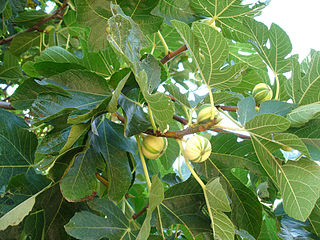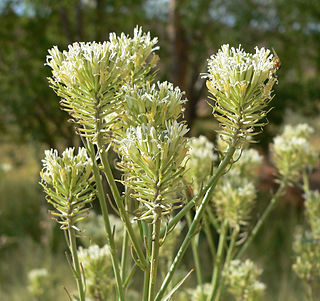
An inflorescence is a group or cluster of flowers arranged on a stem that is composed of a main branch or a complicated arrangement of branches. Morphologically, it is the modified part of the shoot of seed plants where flowers are formed. The modifications can involve the length and the nature of the internodes and the phyllotaxis, as well as variations in the proportions, compressions, swellings, adnations, connations and reduction of main and secondary axes. One can also define an inflorescence as the reproductive portion of a plant that bears a cluster of flowers in a specific pattern.

Variegation is the appearance of differently coloured zones in the leaves, and sometimes the stems, of plants.
A storage organ is a part of a plant specifically modified for storage of energy (generally in the form of carbohydrates) or water. Storage organs often grow underground, where they are better protected from attack by herbivores. Plants that have an underground storage organ are called geophytes in the Raunkiær plant life-form classification system. Storage organs often, but not always, act as perennating organs which enable plants to survive adverse conditions.

Arthropodium milleflorum, the pale vanilla lily, is a species of herbaceous perennial plants native to Australia. It occurs in various habitats including alpine areas and grows to between 0.3 and 1.3 metres high and 0.3 metres wide. The fleshy tubers were eaten by Aboriginal Australians. The plant has a strong vanilla fragrance, especially noticeable on warm days.

Lemon basil, hoary basil, Thai lemon basil, or Lao basil, is a hybrid between basil and American basil. The herb is grown primarily in northeastern Africa and southern Asia for its fragrant lemon scent, and is used in cooking.
Plant reproduction is the production of new offspring in plants, which can be accomplished by sexual or asexual reproduction. Sexual reproduction produces offspring by the fusion of gametes, resulting in offspring genetically different from the parent or parents. Asexual reproduction produces new individuals without the fusion of gametes, genetically identical to the parent plants and each other, except when mutations occur.

Thelypodium howellii, the Howell's thelypody or Howell's thelypodium, is a rare plant of the Western United States. It is endemic to a relatively small area on the borders of three western States: Oregon, Nevada, and California.
This page provides a glossary of plant morphology. Botanists and other biologists who study plant morphology use a number of different terms to classify and identify plant organs and parts that can be observed using no more than a handheld magnifying lens. This page provides help in understanding the numerous other pages describing plants by their various taxa. The accompanying page—Plant morphology—provides an overview of the science of the external form of plants. There is also an alphabetical list: Glossary of botanical terms. In contrast, this page deals with botanical terms in a systematic manner, with some illustrations, and organized by plant anatomy and function in plant physiology.

A stem is one of two main structural axes of a vascular plant, the other being the root. It supports leaves, flowers and fruits, transports water and dissolved substances between the roots and the shoots in the xylem and phloem, stores nutrients, and produces new living tissue.

A weed is a plant considered undesirable in a particular situation, "a plant in the wrong place". Examples commonly are plants unwanted in human-controlled settings, such as farm fields, gardens, lawns, and parks. Taxonomically, the term "weed" has no botanical significance, because a plant that is a weed in one context is not a weed when growing in a situation where it is in fact wanted, and where one species of plant is a valuable crop plant, another species in the same genus might be a serious weed, such as a wild bramble growing among cultivated loganberries. In the same way, volunteer crops (plants) are regarded as weeds in a subsequent crop. Many plants that people widely regard as weeds also are intentionally grown in gardens and other cultivated settings, in which case they are sometimes called beneficial weeds. The term weed also is applied to any plant that grows or reproduces aggressively, or is invasive outside its native habitat. More broadly "weed" occasionally is applied pejoratively to species outside the plant kingdom, species that can survive in diverse environments and reproduce quickly; in this sense it has even been applied to humans.

Caulanthus cooperi is a species of flowering plant in the family Brassicaceae known by the common name Cooper's wild cabbage. It is native to the southwestern United States and Baja California, where it is a common plant in a number of open, sandy habitats. This annual herb produces a slender, somewhat twisted stem with widely lance-shaped to oblong leaves clasping it. The flower has a rounded or urn-shaped coat of pinkish or pale greenish sepals enclosing light yellow or pale purple petals. The fruit is a straight or curving silique several centimeters long.

Thelypodium is a genus of flowering plants in the mustard family. There are 16 to 20 species, all native to western North America. Thelypody is a common name for plants in this genus.
Thelypodium brachycarpum is a species of flowering plant in the mustard family known by the common names shortpod thelypody and short-podded thelypodium. It is native to parts of northern California and southern Oregon, where it grows in several types of habitat, including alkaline wetlands and serpentine soils.
Thelypodium crispum is a species of flowering plant in the mustard family known by the common name crisped thelypody.
Thelypodium flexuosum is a species of flowering plant in the mustard family known by the common name nodding thelypody. It is native to the Great Basin and surrounding plateau habitat in the northwestern United States, from California and Nevada to Idaho.

Thelypodium integrifolium is a species of flowering plant in the mustard family known by the common names entireleaved thelypody and foxtail thelypodium. It is native to much of the western United States, including the Great Basin and surrounding plateaus and deserts.

Thelypodium laciniatum is a species of flowering plant in the mustard family known by the common name cutleaf thelypody. It is native to western North America, particularly the Great Basin and surrounding plateau and foothill habitat, where it grows on dry rocky cliffs and hillsides in sagebrush and scrub, usually below 2,400 metres (8,000 ft) elevation.

Thelypodium stenopetalum is a rare species of flowering plant in the mustard family known by the common names slenderpetal thelypody, slender-petaled thelypodium and slender-petaled mustard. It is endemic to the San Bernardino Mountains of southern California, where it is known from only three or four extant occurrences in moist mountain meadows near Big Bear Lake. Its remaining habitat is considered seriously threatened and the plant is a federally listed endangered species in the United States.
Thelypodium eucosmum is a species of flowering plant in the mustard family known by the common names arrow-leaf thelypody and world thelypody. It is endemic to Oregon in the United States, where it is known from Grant and Wheeler Counties. There are also historical records of the plant from Baker County.
Thelypodium laxiflorum, the droopflower thelypody, is a plant species native to the southwestern United States. It grows in open, rocky places on slopes and cliff faces, usually in pinyon-juniper woodlands at elevations of 4,900–10,200 feet (1,500–3,100 m). It has been reported from Utah, western Colorado, southern Nevada, northwestern Arizona, and northwestern New Mexico.












